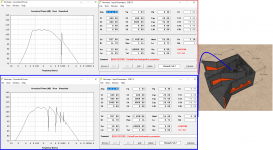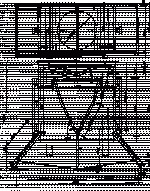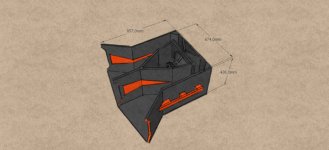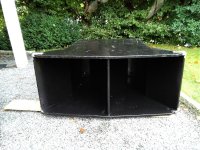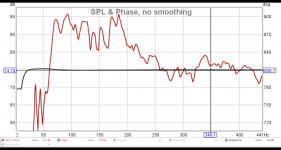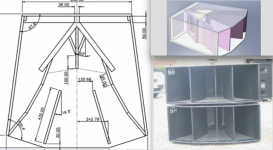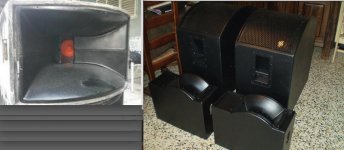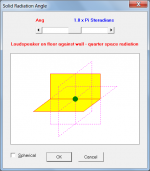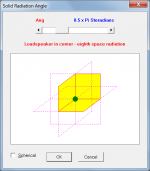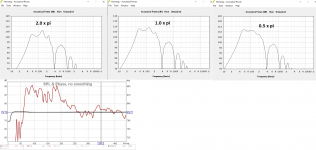Hello!
While impatiently awaiting the arrival of my latest barn find - two Martin SB115 midbass horns loaded with Celestion woofers for €100, I could not help myself to try to model them in Hornresp. I am sure have done a terrible job with the throat, but everything else should be legit. Modelled using FaitalPro 15PR400 8 ohm. I realize one simulation has more segments but they are very similar i geometry.
What strikes me is how large the rear chamber is, and when reducing its ginormous volume of around 40-50 L and 55 cm in length, down to a modest 19 liters and 17 cm in length, it goes from being a funky relic to a real 70Hz midbass horn that meets the subwoofer at 80Hz with no problems.
While impatiently awaiting the arrival of my latest barn find - two Martin SB115 midbass horns loaded with Celestion woofers for €100, I could not help myself to try to model them in Hornresp. I am sure have done a terrible job with the throat, but everything else should be legit. Modelled using FaitalPro 15PR400 8 ohm. I realize one simulation has more segments but they are very similar i geometry.
What strikes me is how large the rear chamber is, and when reducing its ginormous volume of around 40-50 L and 55 cm in length, down to a modest 19 liters and 17 cm in length, it goes from being a funky relic to a real 70Hz midbass horn that meets the subwoofer at 80Hz with no problems.
Attachments
Last edited:
Sure I will. Someone said the Faital Pro 15PR400 will not last long with compression ratios like this. But it is going to be in my livingroom. Still, maybe I should leave them in a bass reflex box to better enjoy their Acoustic Elegance killer midrange.
Real world measurements confirms the Hornresp simulation. Sadly, Hornresp is dead on, unless the dip at 270Hz is because of a room node, which is actually very common.
I measured only a single horn loaded with JBL K140 with E140 recone in my 4.5x4.5m livingroom.
Software: Rew
Mic: Umik-1 calibrated
Distance: 1 meter from mouth
Height: 40 cm
Crossover set to 40-270Hz. Highpass should have been off.
Me playing some tunes with both of them with crossover points at 55-300Hz:
Martin Sound SB115 loaded with K140 and E140 - sound check - YouTube
Conclusion: I have only tested them briefly but I must say that this is a great way if not the only way to use a JBL K140 or E140 in a hifi system. Martin Sound SB115 midbass horns are called "Kickers" and I understand why. The type of midbass is very close to a concert, because this is what they use in concert! At least Supertramp did in the 70's. I have never heard midbass like this unless I was on a concert - never at home.
Sidenote: I used window isolation rubber to isolate the rear lid, but I ran out with one of them and it resulted in much less "kick".
Question is, how long will I enjoy being kicked in the ear drum?
I measured only a single horn loaded with JBL K140 with E140 recone in my 4.5x4.5m livingroom.
Software: Rew
Mic: Umik-1 calibrated
Distance: 1 meter from mouth
Height: 40 cm
Crossover set to 40-270Hz. Highpass should have been off.
Me playing some tunes with both of them with crossover points at 55-300Hz:
Martin Sound SB115 loaded with K140 and E140 - sound check - YouTube
Conclusion: I have only tested them briefly but I must say that this is a great way if not the only way to use a JBL K140 or E140 in a hifi system. Martin Sound SB115 midbass horns are called "Kickers" and I understand why. The type of midbass is very close to a concert, because this is what they use in concert! At least Supertramp did in the 70's. I have never heard midbass like this unless I was on a concert - never at home.
Sidenote: I used window isolation rubber to isolate the rear lid, but I ran out with one of them and it resulted in much less "kick".
Question is, how long will I enjoy being kicked in the ear drum?
Attachments
Last edited:
Lrc may be the reason.
Lrc and Vrc are actually perfect as long as the driver is sidemounted in the simulation. If not, like in my first simulation, then Lrc and Vrc would have needed reduction. It is weird how I manage to get so close to reality. I think what saves the midrange a bit is the aluminium dust cone mounted directly to the voice coil and not the cone like with many other woofers. It is no way perfect, but it actually helps to blend the big woofer with the sound of the aluminium dome in the compression driver.
Last edited:
Nah, the compression drivers start playing from 270/300Hz. At least they will be when I am done with both Jmlc Iwata 220Hz midrange horns.
Unfortunately, that data isn’t very useful or trustworthy; horns must be measured in the far-field, and your room size means that there’s as much room as box in the data. It also can’t be windowed out.
Is there a reason why your Hornresp models are in 1pi? While the concept of 'corner loading' is attractive, I haven't seen many cases where it's achieved in reality other than the horn boxes designed to literally fit into a corner. Even then, it's not achieved for the entire pass band. Hornresp can't model a distance offset from a boundary, so a half-space prediction is generally more useful.
If you re-run the sim as 2pi, and measure outdoors (or even in that barn they were found in) you'll get something more realistic in both graphs 🙂 you'll probably find you have headroom to spare at home whatever driver is in these boxes, so a gentler high pass filter would likely keep the impact through to the sub at the lowest notes. You'll need time alignment either way.
Is there a reason why your Hornresp models are in 1pi? While the concept of 'corner loading' is attractive, I haven't seen many cases where it's achieved in reality other than the horn boxes designed to literally fit into a corner. Even then, it's not achieved for the entire pass band. Hornresp can't model a distance offset from a boundary, so a half-space prediction is generally more useful.
If you re-run the sim as 2pi, and measure outdoors (or even in that barn they were found in) you'll get something more realistic in both graphs 🙂 you'll probably find you have headroom to spare at home whatever driver is in these boxes, so a gentler high pass filter would likely keep the impact through to the sub at the lowest notes. You'll need time alignment either way.
But the 2 pi is always so ugly! 😛
Thanks for the feedback. I am still learning so it is great to have more experienced comment. After my little test today, I am not concerned if they can go low, but I wonder if they can be used for any type of midrange really. Ideally I would cross them 75Hz to 300Hz and have the option to cross them at 400Hz. But my other midbass solution, which is now the 15PR400 15" ported in a 92L box tuned to 48Hz (I think), sound much cleaner in the midrange. And a lot less concert like in the midbass.
I don't see the point dragging them outside if I am not going to listen outside, unless I really want to know what my room is doing to the sound and if it needs treatment. Rear wall is concrete, the other is windows. I think I am pretty much screwed in this apartment.
Thanks for the feedback. I am still learning so it is great to have more experienced comment. After my little test today, I am not concerned if they can go low, but I wonder if they can be used for any type of midrange really. Ideally I would cross them 75Hz to 300Hz and have the option to cross them at 400Hz. But my other midbass solution, which is now the 15PR400 15" ported in a 92L box tuned to 48Hz (I think), sound much cleaner in the midrange. And a lot less concert like in the midbass.
I don't see the point dragging them outside if I am not going to listen outside, unless I really want to know what my room is doing to the sound and if it needs treatment. Rear wall is concrete, the other is windows. I think I am pretty much screwed in this apartment.
Last edited:
The real secret to the Martin sound was the use of cone midbass, the 2x12" "Philishave" was an industry game-changer.
Your SB115 bins were never designed to be used above 200 Hz, and were designed to be used in stacks, 8 tall would be common, 60 or more in a system.
I'd highly recommend using cone mid horns between your SB115 and your Jmlc Iwata 220Hz midrange horns.
Simulate them in 2 pi with 8 cabinets, and you will see why the rear chamber was large, your "shrinkage" would require four times the power (which would have burnt the voice coils of the 1970s even if the power was available then) for decent 40Hz response.
The Martin 215 used even larger back chamber volume.
My larger (US truck integer size) 2x15" & 4x15" L2 & L4 "Clams" were based off those, after Steve Raitt described the 215 cabinets, and how plaster started falling from the ceiling with each kick drum beat during a Supertramp sound check (perhaps March 24 1979).
Anyway, another trip down memory lane.
Art
Your SB115 bins were never designed to be used above 200 Hz, and were designed to be used in stacks, 8 tall would be common, 60 or more in a system.
I'd highly recommend using cone mid horns between your SB115 and your Jmlc Iwata 220Hz midrange horns.
Simulate them in 2 pi with 8 cabinets, and you will see why the rear chamber was large, your "shrinkage" would require four times the power (which would have burnt the voice coils of the 1970s even if the power was available then) for decent 40Hz response.
The Martin 215 used even larger back chamber volume.
My larger (US truck integer size) 2x15" & 4x15" L2 & L4 "Clams" were based off those, after Steve Raitt described the 215 cabinets, and how plaster started falling from the ceiling with each kick drum beat during a Supertramp sound check (perhaps March 24 1979).
Anyway, another trip down memory lane.
Art
Attachments
Thanks, I was told this before receiving them, which bummed me out, but it is a lesson really. To get that deep kick you need to sacrifice some midrange, at least with this design. One thing that has always bugged me is that 15" drivers usually don't sound that great. After stuffing them in a horn, even JBL K140/E140 that are excellent for this purpose, you are just listening to the bad stuff more clearly. I would like to do the same thing but with an 8" driver. Actually two, one for midrange and one for moving air, like in this horn. It would need to be large, but again, just moving air. No need for midrange.
Not looking for 40Hz. I will use a simple subwoofer for that. 75Hz is fine by me. I think 40Hz was just a marketing gimmick. 😛
Not looking for 40Hz. I will use a simple subwoofer for that. 75Hz is fine by me. I think 40Hz was just a marketing gimmick. 😛
Last edited:
If 100Hz is OK my midbass horn design can play higher with a 15" (400Hz). Mega midbass straight horn 139dB
I am using an exceptional driver in it though.
I am using an exceptional driver in it though.
Is there a reason why your Hornresp models are in 1pi? While the concept of 'corner loading' is attractive, I haven't seen many cases where it's achieved in reality other than the horn boxes designed to literally fit into a corner.
Just to clarify:
1.0 * Pi or quarter space radiation assumes that the loudspeaker is on the floor against a wall.
0.5 * Pi or eighth space radiation assumes that the loudspeaker is in a corner.
Attachments
I had it fairly close to the wall, but the mouth ended up in the middle of the room, because I don't live in a castle.
Attachments
Last edited:
Yeah, this is what I meant. Thanks for clarifying David. It’s a useful concept but I’ve never really achieved the predicted response in reality with ‘pro horns’ due to the size putting the mouth a good metre away from any wall in practice.
- Home
- Loudspeakers
- Multi-Way
- Martin SB115 midbass horn - rear chamber size issue
